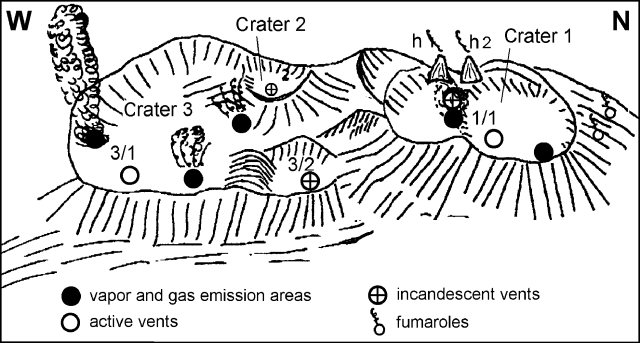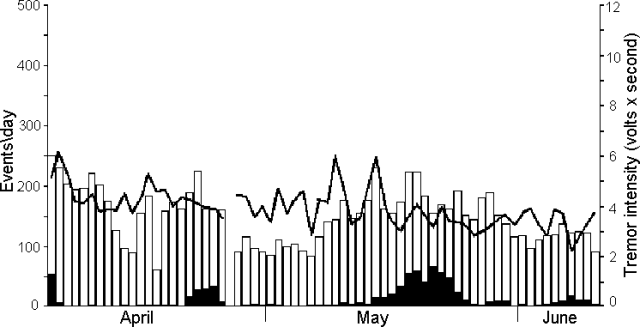Report on Stromboli (Italy) — May 1995
Bulletin of the Global Volcanism Network, vol. 20, no. 5 (May 1995)
Managing Editor: Edward Venzke.
Stromboli (Italy) Slight late-May increase in seismicity; crater observations
Please cite this report as:
Global Volcanism Program, 1995. Report on Stromboli (Italy) (Venzke, E., ed.). Bulletin of the Global Volcanism Network, 20:5. Smithsonian Institution. https://doi.org/10.5479/si.GVP.BGVN199505-211040
Stromboli
Italy
38.789°N, 15.213°E; summit elev. 924 m
All times are local (unless otherwise noted)
During the 5 April-10 June reporting interval, the most significant low-intensity period occurred between 27 April and 6 May (figure 43), with an average of
The second half of May was characterized by a reprise in the total number of recorded events and in the number of events that saturated the acquisition system with ground velocities >100 µ/s. Access limitations imposed by local authorities were also eased once normal activity resumed. A slight decrease in seismicity characterized early June, with ~100-150 events/day, only a few major shocks, and continued low tremor intensity.
During 30 April-1 May Richard Pichl observed powerful explosions every 20-25 minutes, throwing incandescent ejecta from a vent in the northernmost part of Crater 1 onto the Sciara del Fuoco, each accompanied by a "cannon-shot" bang. There was also a 1-2 hour period of continuous, violent degassing. A second vent in the central part of the crater erupted once during the night. Black ash plumes rose from Crater 3; no incandescent ejecta were reported. There was unusually strong fumarolic activity from numerous sources within Crater 1.
On the night of 23-24 May, SVE members observed explosive Strombolian activity from the Pizzo Sopra after several weeks of weak activity. Vent 3/1 (figure 44) was the most active, with intense explosions at ~15-25 minute intervals sending incandescent ejecta ~100 m above Crater 3. Vent 3/2, inside a small depression, displayed continuous incandescence with occasional weak jets and sprays of lava. Vent 1/1 ejected incandescent material every 30-40 minutes SW onto the outer slope of Crater 1 and the rim of Crater 3. Two hornitos near the rim of Crater 1 exhibited weak vapor emissions. Yellow sulfur deposits surrounded several fumaroles on the external slope of Crater 1. Intense vapor emissions from several areas in Craters 1 and 3 were observed.
 |
Figure 44. Sketch of the active craters at Stromboli, 24 May 1995. View is from the Pizzo Sopra looking NW. Courtesy of H. Gaudru. |
Geological Summary. Spectacular incandescent nighttime explosions at Stromboli have long attracted visitors to the "Lighthouse of the Mediterranean" in the NE Aeolian Islands. This volcano has lent its name to the frequent mild explosive activity that has characterized its eruptions throughout much of historical time. The small island is the emergent summit of a volcano that grew in two main eruptive cycles, the last of which formed the western portion of the island. The Neostromboli eruptive period took place between about 13,000 and 5,000 years ago. The active summit vents are located at the head of the Sciara del Fuoco, a prominent scarp that formed about 5,000 years ago due to a series of slope failures which extends to below sea level. The modern volcano has been constructed within this scarp, which funnels pyroclastic ejecta and lava flows to the NW. Essentially continuous mild Strombolian explosions, sometimes accompanied by lava flows, have been recorded for more than a millennium.
Information Contacts: Roberto Carniel, Dipartimentto di Georisorse e Territorio, via Cotonificio 114, I-33100 Udine, Italy; Henry Gaudru, Societe Volcanologique Europeenne (SVE), C.P. 1 - 1211 Geneva 17, Switzerland; Richard Pichl, Institute of Hydrogeology, Engineering Geology & Applied Geophysics, Charles University, Prague, Czech Republic.


